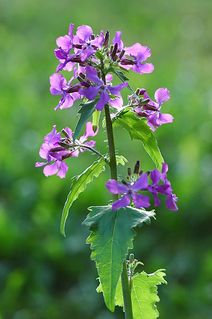Lunaria annua
| Lunaria annua | |
 | |
| Light: | |
| Moisture: | |
| Hardiness: | 6 |
| Soil pH: | 5.6-8.4 |
| Self Pollinated | |
| Height: | 2' |
| Width: | 1' |
| Speed: | Fast |
| Blooms: | Late Spring-Mid Summer |
| Native to: | |
| Shelter | |
| Edible Rating: | |
| Tea: | Yes |
Lunaria annua (common name: honesty)
Propagation: Seed - sow early spring or early autumn in situ[1]. The plant will often self-sow.
Cultivation: Succeeds in ordinary garden soil[2]. Prefers a light soil[3]. Prefers partial shade but also succeeds in full sun[4]. Established plants tolerate drought[5].
Plants are hardy to about -15°c[1].
A good bee and butterfly plant[6].
Often grown in the flower garden[2], it is occasionally cultivated for its root[7].
Plants are fast-growing and usually self-sow freely[4].
Range: Europe - Sweden. More or less naturalized in Britain.
Habitat: Moist soils in full sun or light shade, avoiding acid soils.
Edibility: Seed - cooked. A pungent flavour, they are used as a mustard substitute[8]. The pungency of mustard develops when cold water is added to the ground-up seed - an enzyme (myrosin) acts on a glycoside (sinigrin) to produce a sulphur compound. The reaction takes 10 - 15 minutes. Mixing with hot water or vinegar, or adding salt, inhibits the enzyme and produces a mild bitter mustard[9].
Root - raw[10][7][11]. Used before the plant produces flowers[12][8].
Pollinators: Bees, flies, lepidoptera, self
Soil: Can grow in light, medium, and heavy soils.
Seed Ripens: Early Summer-Late Summer
Flower Type: Hermaphrodite
Also Known As: L. biennis.
Links
References
- ↑ 1.0 1.1 Huxley, Anthony. The New Royal Horticultural Society Dictionary of Gardening. MacMillan Press, 1992.
- ↑ 2.0 2.1 Chittendon, Fred. RHS Dictionary of Plants. Oxford University Press, 1951.
- ↑ International Bee Research Association. Garden Plants Valuable to Bees. International Bee Research Association, 1981.
- ↑ 4.0 4.1 Brickell, Christopher. The RHS Gardener's Encyclopedia of Plants and Flowers. Dorling Kindersley Publishers, 1990.
- ↑ Chatto, Beth. The Damp Garden. Dent, 1982.
- ↑ Carter, David. Butterflies and Moths in Britain and Europe. Pan, 1982.
- ↑ 7.0 7.1 Usher, George. A Dictionary of Plants Used by Man. Constable, 1974.
- ↑ 8.0 8.1 Facciola, Stephen. Cornucopia - A Source Book of Edible Plants. Kampong Publications, 1990.
- ↑ Bown, Deni. Royal Horticultural Society Encyclopaedia of Herbs and Their Uses. Dorling Kindersley, 1995.
- ↑ Hedrick, Ulysses. Sturtevant's Edible Plants of the World. Dover Publications, 1972.
- ↑ Kunkel, Günther. Plants for Human Consumption. Koeltz Scientific Books, 1984.
- ↑ Uphof, Johannes. Dictionary of Economic Plants. Weinheim, 1959.